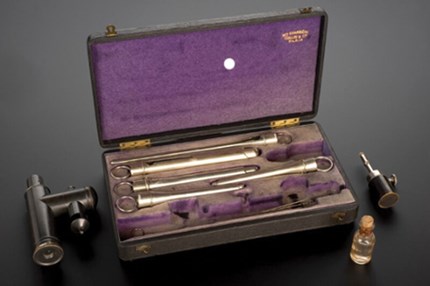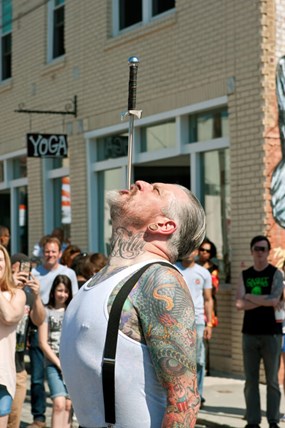Adolf Kussmaul drew inspiration from an unlikely source to further the development of endoscopy…
The early pioneers of airway endoscopy and oesophagoscopy were bedevilled by two major and seemingly insurmountable problems. One was the paucity of light sources, with reliance on candles, oil lamps and a variety of ingenious mirror devices to project the light into a primitive endoscope.

Figure 1. Desormeaux type endoscope, Paris, France, 1861-1880.
Image credit: Science Museum, London - https://wellcomecollection.org/works/p2zvuzqw
Desormeaux’s ‘lamp’ (Figure 1), exhibited in Paris in 1853, and ostensibly used to inspect the rectal mucosa, was one such device. The other major impediment was the difficulty of introducing a rigid tube into the aerodigestive tract, and safely navigating the cervical spine.
“Leiter induced some young men to imitate the sword swallowers’ technique by introducing rigid rubber ‘sticks’ into the oesophagus, so that with practice they could tolerate a metal tube”
When working at his clinic in Freiburg, Germany, the enterprising physician, Adolf Kussmaul, was struck by the great skill of local sword swallowers. These were a common sight in European cities in the 19th century, where they were popular street entertainers. They would gather a crowd of onlookers who would offer a few coins each in exchange for a demonstration. The sword swallower has to master the very difficult and hazardous technique, often taking years to refine it. The sword is introduced in inspiration, years of practice subverting the gag reflex. The posture and angulation of the cervical spine is of course vital, and the sword swallower develops the ability to relax the crico-pharyngeus as he introduces the blade so that it can be thrust downwards as far as the stomach (Figure 2). Some of the earliest subjects used to demonstrate the possibilities of rigid oesophagoscopy were professional sword swallowers.

Figure 2.
The idea was taken up by von-Mikulicz, a young Polish lecturer (Docent) in surgery, working at the Allgemeine Krankenhaus in Vienna under the supervision of Billroth. Von-Mikulicz – who went on to become the Professor of Surgery in Breslau, now Wroclaw – commissioned the celebrated instrument maker, Johann Leiter, to make some rigid tapered metal tubes which became the first oesophagoscopes. Leiter induced some young men to imitate the sword swallowers’ technique by introducing rigid rubber ‘sticks’ into the oesophagus, so that with practice they could tolerate a metal tube. Von-Mikulicz demonstrated rigid oesohagoscopy to a captive audience of would-be endoscopists, who, anxious to learn the new technique, flocked to his clinics. The demonstrations were of course without anaesthesia, and some of the postures adopted by the subjects were very bizarre indeed! I suspect, given the poor light source, little could be seen but the possibilities were becoming clear.
“The demonstrations were of course without anaesthesia, and some of the postures adopted by the subjects were very bizarre indeed”
Gustav Killian, the pioneer of ‘suspension laryngoscopy’ and of rigid bronchoscopy, was working in Freiburg before he took the chair of laryngology in Berlin, and helped to popularise both rigid oesophagoscopy and bronchoscopy, which only really became useful at the turn of the 20th century when electric lightbulbs became widely available.
Modern-day endoscopic surgery, with high-fidelity screens, monitors, and the seemingly endless possibilities of navigating body cavities through ever smaller incisions, would surely have seemed impossible to the early pioneers of endoscopy. Spare them a thought when you next complain about a smudge on the lens of your scope!




